The Joint Expedition of the British Museum and the University Museum to Mesopotamia resumed excavations at Ur of the Chaldees and at the adjoining site of Tell el Obeid at the beginning of November last. Reports have been received from Mr. C. Leonard Woolley, the Director of the Expedition, showing the progress of the work from month to month. Abstracts of these reports are herewith printed together with some of the photographs made by the Expedition.
EDITOR.

Image Number: 171550
November 5, 1923.
I had proposed to travel to Baghdad from Aleppo, taking with me the native foremen from Jerablus, whom I had gone north to secure; but owing to the formalities connected with the granting of their passports, I went back to Beyrouth and took passage from there to Baghdad in the Nairn Company’s cars. I left Beyrouth on October 24 for Damascus, where I met Mr. Gadd, and we went on together to Baghdad, arriving there on the morning of October 28. At Baghdad Mr. Fitzgerald was waiting for us, having reached the town a week before.
We left Baghdad on October 31 and arrived at Ur on the following evening; we were kindly given quarters at the railway station pending the putting in order of the expedition house. My Jerablus foremen arrived on the night of the 2nd of November, and the goods stored at Basra and those sent out during the summer from England were sent up here by our Basra agents on the second and third of the month; I hope that work on the house will be finished tomorrow, November 4, except for the building of a garage and of a new room for the foremen. Excavation proper is to start on Monday next, the 5th instant.
I am glad to report that the guards left in charge of the house and site during my absence have done their work well; all the property stored here is intact and in good order, and no wilful damage has been done to the site. The excavations have been to a considerable extent filled up by drift sand and a few of the walls badly weathered; this is unavoidable, and only justifies my intention of reburying excavated sites, after a decent interval, with spoil heaps from neighbouring areas; it is of advantage to have certain buildings open for the inspection of visitors, but it is useless to try to keep any permanently open as show places in a country where the sand drifts of a single summer suffice to rob them of most of their interest.
I shall begin work on the ziggurat (stage tower) on Monday next; work at Tell el Obeid should start a few days later.
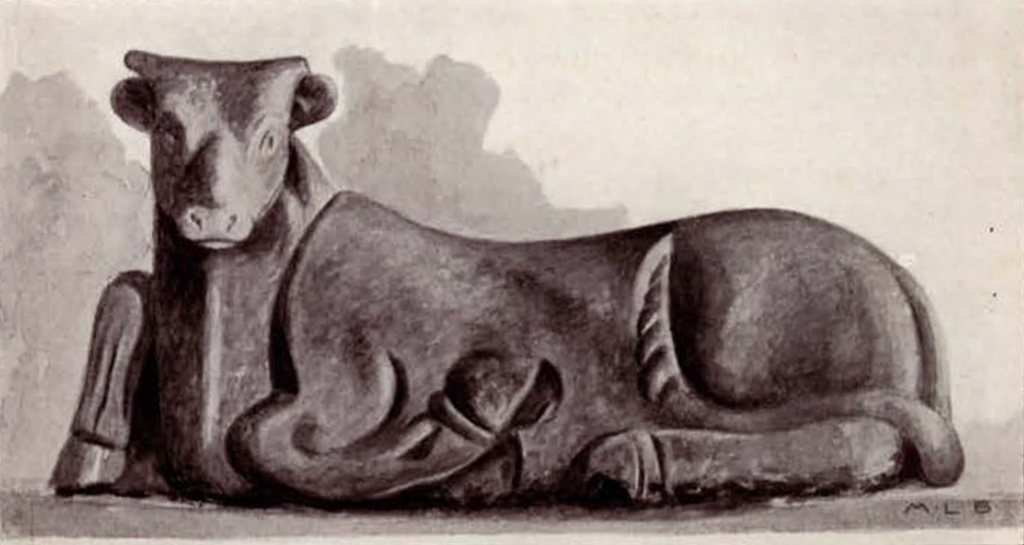
Image Numbers: 9133, 9134, 9135, 171551
November 17, 1923.
At Ur I have been working with one hundred and thirty men. Good progress has been made with the clearing of the southwest face of the ziggurat, and though much remains to be done results are already satisfactory. Until Mr. Newton arrives and a properly professional study can be made of the architectural features of the ziggurat, I do not wish to put forward any theories; but it seems fairly clear that we have remains of four stages in the building (which presumably therefore had seven stages, not four, as we had hitherto supposed) and certain deductions can be drawn as to the date and original character of the different elements in the structure. Fragments of foundation cylinders have been found recording the late work on the building carried out by Nabonidus, but otherwise the heavy labour of removing hundreds of tons of debris has not produced any movable antiquities of interest; such, if they occur at all, can only be found in the ultimate stages of the work.
On Monday the 13th inst. I started work at Tell el Obeid. The carrying on of excavations at two sites more than four miles apart has only been made possible by the presence of more than one trained native foreman and by the use of a car. Water for the workmen has to be brought from Ur Junction, a distance of six miles; for this donkeys are employed, by contract, as being cheaper and more certain than motor transport, but even so the cost is above a pound per diem. Guards have to be employed on the site and the workmen have to be provided with tent accommodation and firewood. The site has proved remarkably rich. House remains and tombs have been found of the earliest period, extending probably to the time of the Third Dynasty of Ur, and these have yielded great quantities of pottery, stone implements and bronzes which will throw much light on the history of the time as well a: form valuable Museum material.
The health of the members of the Expedition continues to be good. Weather is favourable, and there has been nothing to interrupt the work or disturb its progress.

Image Number: 171549
November 30, 1923.
Excavation proper started on November 5th, Monday, 122 men being employed at the start. As my arrival became known, more of my old hands turned up, and the numbers of men employed increased to about 180. During the first week operations were confined to Ur, as the proposed campaign at Tell el Obeid needed more elaborate preparations; tents had to be provided for the workmen, and firewood, a water supply had to be arranged, and extra guards engaged through the local Sheikh; moreover, as the men were distinctly nervous of working and living so far out in the desert, I thought it advisable to make a departure from usual rules and to arrange for a certain proportion of the men having arms with them. On Monday, 12th, my second foreman, Khalil, was left in charge at Ur, while Hamoudi with 60 men was sent to Tell el Obeid; since then work has been carried on regularly at both sites; I have had to devote most of my time to the Obeid excavations, while Mr. Gadd and Mr. Fitzgerald have taken it in turn to supervise the clearing of the Ur ziggurat.
The clearing of the ziggurat has proved heavier and slower than I had expected. On an average, 150 men have been employed on that job, with four lines of light railway, and after four weeks one face of the tower has been cleared, and on that a certain amount of work yet remains to be done. Hundreds of tons of debris have been removed, and the whole face of the tower has been laid bare. The result is certainly imposing. Until Mr. Newton shall have made a detailed study of the building, I do not care to say much as to the new information given by our work; but it seems fairly clear that we have the remains of four distinct stages, of which the lowest only was the work of the Third Dynasty kings, while the whole of the upper part was due to Nabonidus. Fragments of the foundation cylinders of the latter ruler have been found, and constitute practically the sum of the objects obtained by this heavy and expensive, but in my opinion most important, branch of our work.
On the other hand, the discoveries at Tell el Obeid have been of a very remarkable order.
I started operations on a low mound which proved to be a natural island, the cultural strata on which have suffered greatly from wind and water denudation. There were never on it any proper buildings, but only simple huts of wattle and daub inhabited by a few people probably concerned with the neighbouring temple. But the whole mound was used as a cemetery from the earliest times; I have not yet been able to work out any sequence, but those graves which I was inclined to regard as comparatively late prove to be not inconsistent with a First Dynasty of Ur date, before 4000 B.C., and I think it probable that this section of the cemetery in which we have been digging was not used after the beginning of the Third Dynasty, B.C. 2300. Forty five graves were recorded in the first week; they yielded masses of plain pottery—some 200 complete or nearly complete specimens—and a few painted pieces, flint and obsidian implements, stone vases, copper tools and bowls, clay imitations of stone and copper tools, a few beads and some small objects. One vase is peculiarly interesting as bearing an early Sumerian inscription incised in the clay. The bones had for the most part decayed entirely, but we have secured some half dozen skulls and one complete skeleton, material which in view of its date ought to prove of the greatest importance for the solution of the Sumerian race question.
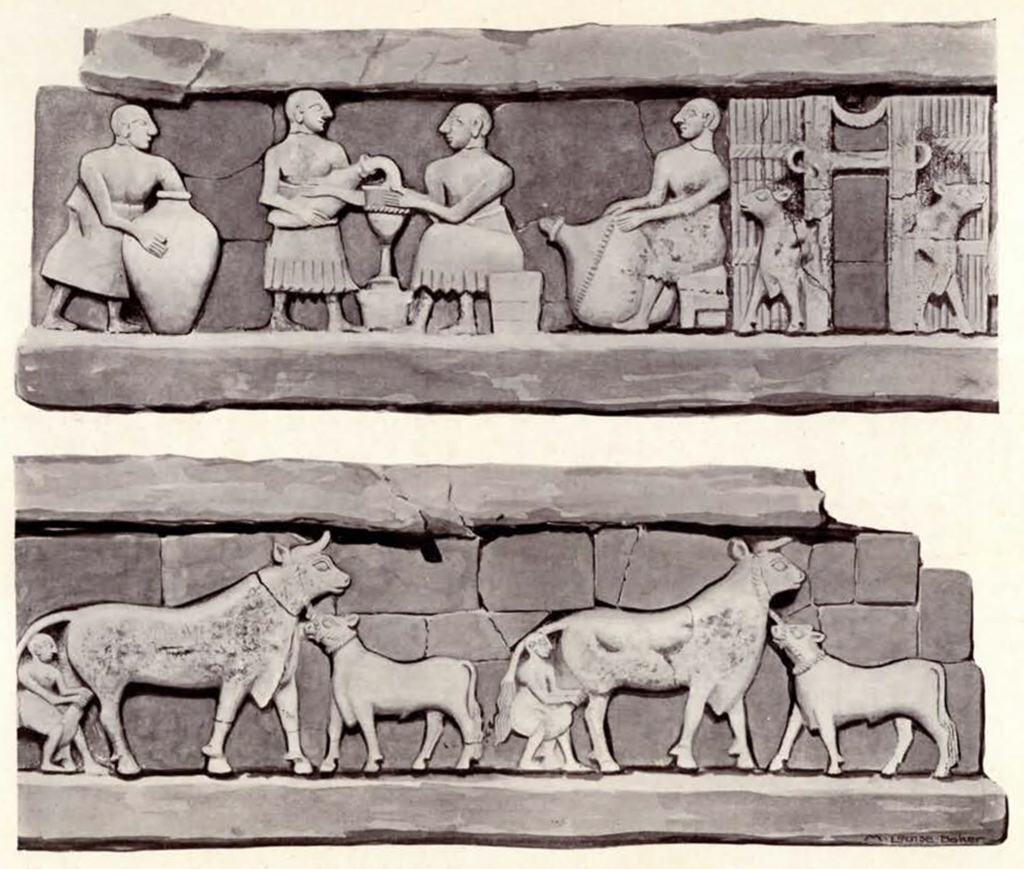
The amount of material afforded by the tombs and requiring attention was such that in the second week I moved the men on to the small building whose excavation was begun by Dr. Hall, intending to resume operations on the graves when the catalogue of objects had been brought up to date. This building has proved no less productive than the cemetery.
There are three buildings on the site. The first in date was the small building of Dr. Hall’s plan, a rectangle with a projecting platform containing a staircase on its southern side, and another projection approached by a massive stone staircase on its southeast; it consisted of a platform with a containing wall of baked piano convex bricks, above which rose a building of piano convex mud bricks; the projections were in mud brick. The building was a temple of the goddess Ninkhursag, erected by the (hitherto unknown) King A-an-ni-pad-da, son of King Mes-an-ni-pad-da of the First Dynasty of Ur, about B.C. 4300, the third dynasty, according to Babylonian tradition, after the Flood. The marble foundation tablet, from which we derive our information, is the oldest dated document ever yet found; it proves the historic existence of a dynasty hitherto commonly regarded as mythical, and it gives a date, if not an authorship, for a very remarkable series of art objects.
The temple was decorated with a series of copper reliefs, 20 centimeters high, of reclining bulls; of these we have found up to date five more or less complete examples and two heads. The photos I send cannot do justice to these very remarkable works of early art ; it is difficult enough to remove such delicate things from the mud brick in which they are embedded and to take the necessary measures for their preservation; to prepare them for exhibition is beyond our means and the limits of our time. Another form of decoration was by inlay in white limestone and other materials; the more complete examples of this that we have as yet show bulls and birds, which were set against a black background. Inlay was indeed very common. In stone we have fragments of a very large vase (or well head?) with reliefs of a peculiarly primitive character, contrasting strongly with the realistic art of the copper bulls, and a tantalising fragment of an animal relief on a large scale; two or three inscribed vase fragments are also more important for the promise they give of further finds than for their actual contents. Of the curious mosaic flowers we have numerous examples, some intact, with their petals in their original positions; whatever they were, they were not for insertion in walls; they seem rather to have stood upright on their long stalks, and perhaps formed an artificial garden.
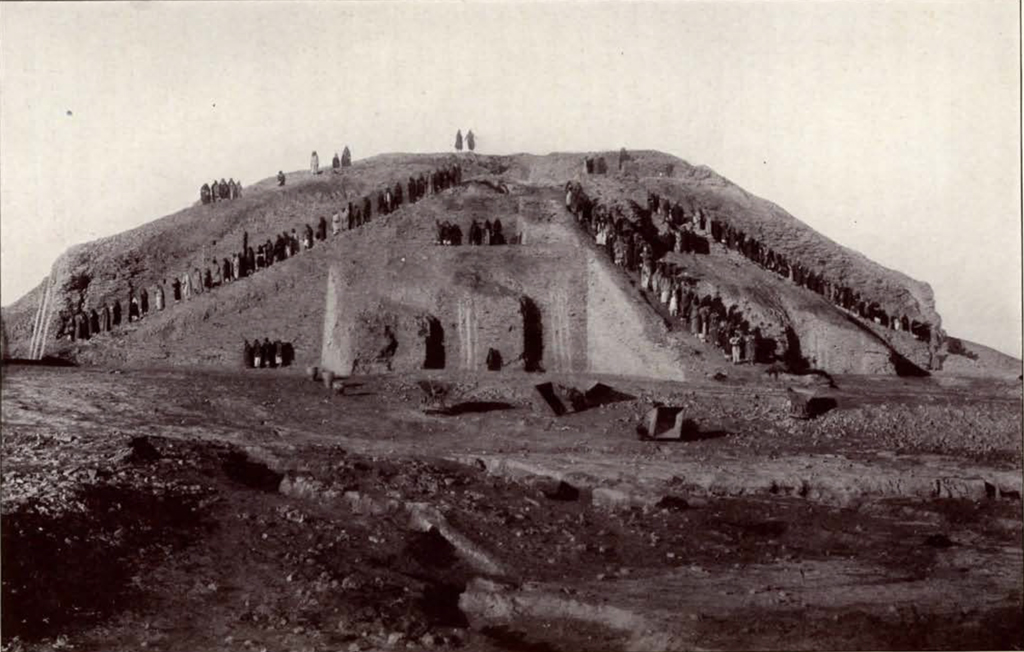
Image Numbers: 143972, 8734a
A great deal of work remains to be done at Tell el Obeid, particularly for the complete elucidation of the plan. At present we can say very little about the later buildings. What is clear is that the First Dynasty temple was destroyed and that when it was rebuilt its whole plan was changed. The area was much enlarged, a new wall was put up enclosing the whole of the hill on the top of which the original structure stood, and the hill was terraced with solid mud brick masonry under which the old temple was completely buried ;—all the objects mentioned above, which belong to the first period, lie under some five feet of mud brick, embedded in the debris of the earlier walls. The mud bricks of the second period are square, and their grey colour contrasts with the red of the first building; the burnt brick of the same period is also square yet bears the indented finger prints which characterise the piano convex bricks but are unknown later. This building may well belong to the Second Dynasty of Ur, about B.C. 3800. Later on it in its turn was destroyed, and on its enlarged upper terrace rose a temple constructed by Dungi, second king of the Third Dynasty, B.C. 2250. No remains of these later buildings worthy of note have yet been recovered.
Work is continuing on both sites, and I have every hope of success in the future equal to that already obtained.
Weather conditions have been unexceptionally favourable, and the health of the members of your Expedition has been uniformly good.
December 31, 1923.
Early in the month heavy rains interrupted the excavations at Tell el Obeid for two and a half days and at Ur for a day and a half ; otherwise weather conditions have been remarkably favourable. This one brief interval was far from unwelcome, as it enabled us in some measure to catch up with the arrears of work in the house, which had become, and still are, serious. Christmas Day was observed as a holiday; the opportunity was taken to visit some of the small sites in the neighbourhood from which antiquities have been occasionally brought in to us. Otherwise work in the field has been continuous. At Ur the average number of men employed has been 120, Khalil id Jadur of Jerablus being foreman, assisted by Yahia, Hamoudi’s son; Mr. Gadd and Mr. Fitzgerald have divided between them the supervision of this work, to which I have been able to give only occasional attention. At Tell el Obeid 60 men have been employed under Hamoudi, and I have been in regular charge throughout with assistance from either Mr. Gadd or Mr. Fitzgerald when such was required.
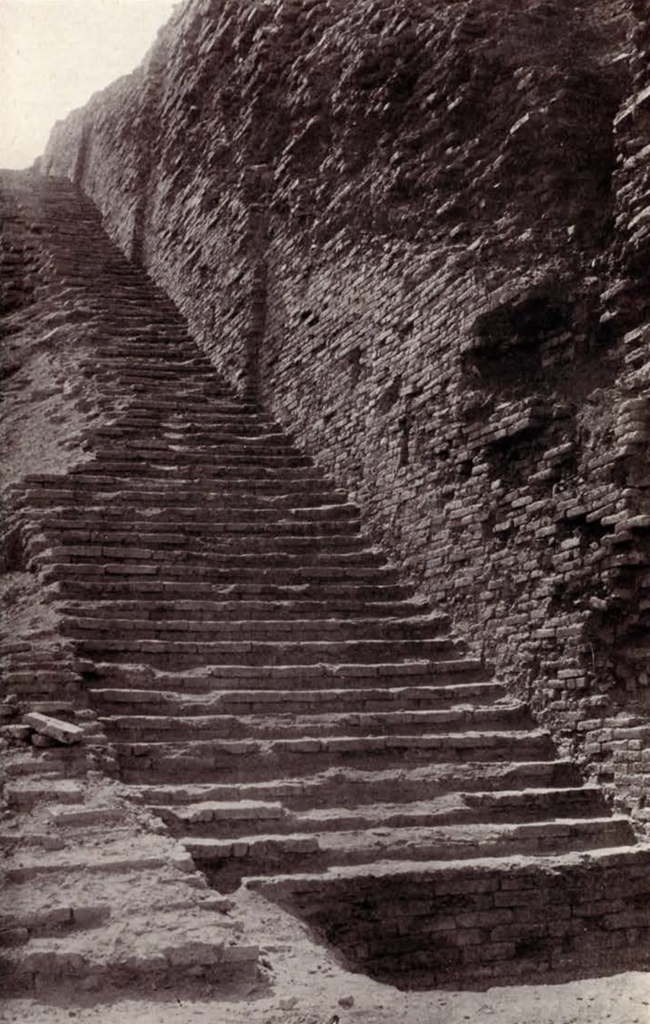
The excavation of the southwest face of the Ziggurat at Ur has been completed down to the later floor levels, which are practically those of the Third Dynasty, B.C. 2300-2200. A complex of chambers of a curious type has been laid bare, the buildings running right up to the ziggurat face and occupying all the area between it and the Temenos wall. In the doorway of one of the chambers was found a good inscribed gate socket of Bur-Sin, but this was the only object of importance unearthed in the course of the whole excavation; however, the work was undertaken with the full knowledge that objects were not likely to accrue, and the scientific results of the dig are fully adequate to the labour expended on it.
I proposed to deal next with the northeast face of the building, where there is reason to hope that the staircase may be found leading to the top of the first stage of the tower; but was faced with a considerable difficulty regarding the disposal of the rubbish. For the southwest face, a wadi breaching the line of the town wall had offered a convenient dumping ground; but to carry thousands of tons of earth right round the ziggurat from the northeast side to this wadi would have doubled the expense of the work, and to the northeast the only low lying ground was within the Temenos area, where buildings had certainly once stood, though another wadi had here too scoured out a channel which looked as if it might be below foundation level. This was a tempting area for our dump; but I decided that before it was so used it should be tested to prevent the possible burial of antiquities beneath our own rubbish. Consequently trenches were dug across the low ground, and almost at once walls were encountered which seem to be those of a temple dedicated to the deified king Gimil-Sin, B.C. 2220; and it became necessary to clear this building before continuing our main task of clearing the Ziggurat. This work is now in progress. Inscribed gate sockets of Gimil-Sin and of Kuri-Galzu, B.C. 1580, have been found in rooms bordering what seems to be the principal court of the temple. The temple itself appears to lie at the foot of a great terrace stretching up to the ziggurat; the containing wall of the terrace is decorated with a double row of engaged columns built of brick which are standing to a considerable height and retain their mud plastering and whitewash. The excavation of this large building should not take very long, and may prove remunerative; in any case, it is of great interest, and is essential to the continuation of work on the ziggurat.
A number of small antiquities have been brought in to us from an outlying part of the site, vases, cylinder seals, and good terra cottas which continue the series obtained last season from the same spot. As it is impossible to protect the area in question, which lies within the zone of occasional cultivation, and as it is desirable to learn as much as possible of the condition in which these figures are found—and to secure more of them—I propose to put in one or two days’ work with our whole Ur gang on this site; the interruption to our main work will be small, and the results in the form of objects should be excellent.
At Tell el Obeid the excavation of the Nin-Khursag temple is complete except for the investigation of one or two underground features; most of the men were taken off on December 22.
The objects discovered at Tell el Obeid during the month have far surpassed in number and importance what I was able to report to you at its beginning. As is natural when architectural decoration is concerned, there has been a good deal of repetition, but even where this was the case it was gratifying to find that the further we went into the mound the better preserved were the objects it contained. The artificial flowers are now very numerous. The copper reliefs of bulls, of which I reported five, now number twelve more or less complete specimens and two spare heads; all these will be fine Museum exhibits. There were found four statues of bulls in the round, made of thin copper plates on a wooden core which had gone to powder; three were headless, the fourth has a head but no horns; these were made separately, in a different material, and there can be little doubt that they were in gold, like the horn found by Dr. Hall. One of the bulls was in a hopeless condition; a second, better preserved, collapsed on removal, but may be capable of restoration; the other two I hope to be able to remove, though their removal is the hardest task that Tell el Obeid has yet set us.
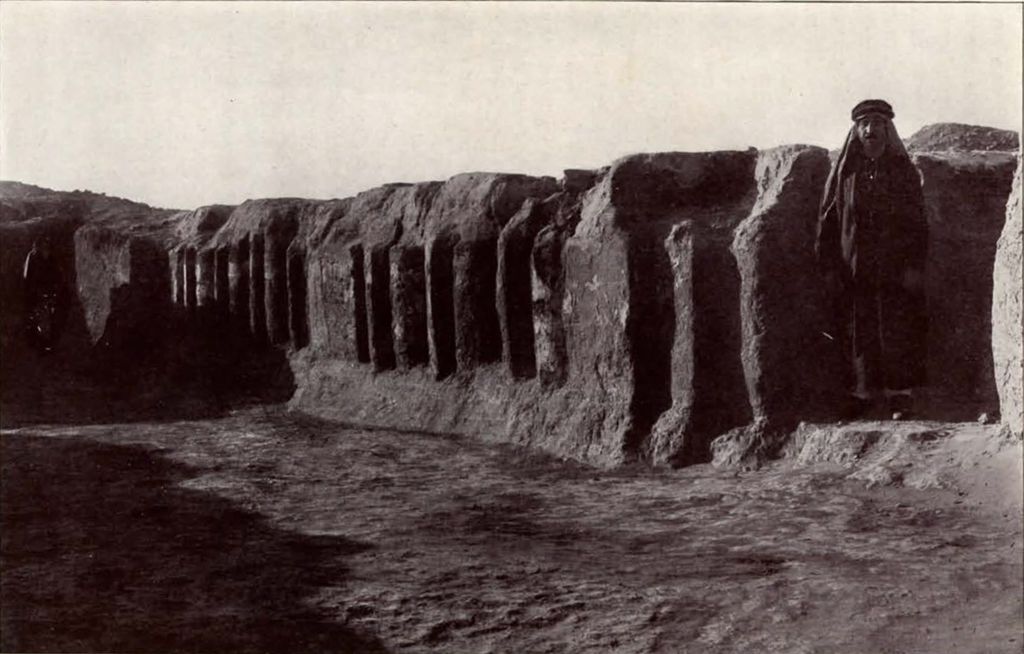
Two mosaic columns were found, each 2.30 meters long. The greater part of one of these, removed with the tesserae in position, has been applied to a modern core and represents the column in its condition as found, i. e., with a certain amount of distortion, with some tesserae missing, and others shifted from their place; the remainder of this and the whole of the second column have been similarly removed, but their reconstruction as columns has been deferred for the present, and the drums are being kept in the flat. The successful lifting of these columns was also a difficult task, but we have at least an unexpected illustration of temple decoration at the period and a very fine Museum piece.
In my last report I spoke of two bulls carved in relief in white limestone for inlay. At the beginning of the month we found examples like these but much more delicately carved in shell. Then a complete panel was discovered. It was lying on its face in the hard soil; the board which had been its original backing had disappeared and the bitumen which had fastened the inlay to the board was reduced to powder with no more powers of adhesion. The bitumen was hardened with wax and the copper border framing the relief was thoroughly strengthened, and the panel was lifted intact. It shows five oxen, carved in white shell and set against a mosaic background formed of pieces of bitumen paste; the whole is quite perfect. The panel not only illustrates Sumerian art in a combination of materials which one would never have expected to recover in good condition from a soil generally so adverse to the preservation of antiquities, but it proves that art to have possessed a technical quality which in the fifth millennium B.C. can only be called amazing. Later, a similar panel with six cattle was recovered, also complete, but in less perfect condition, as the whole panel had buckled in the middle at the time of its fall, and several of the pieces of inlay have been pushed out of position; it needs more work than I can afford to put in here to restore the pieces to their place, but the panel will be just as fine a thing as the first. A third panel, exactly similar, is less complete; three bulls are intact, but of the other two the background has fallen away and the animals themselves are separated from their setting; this piece therefore needs a certain amount of reconstruction. Another smaller fragment has two bulls, carved in stone instead of in shell, and the head of one of these is missing. The finest of all, though it is carved in stone instead of in shell and is consequently rougher in execution, is no less than 1.15 meters long. When found, the two ends were bent out of the straight and some of the inlay there had started from its position and a few pieces were missing; these ends have been straightened out and the inlay replaced. The relief shews on the left a group of four men engaged in the straining and storing of some liquid, wine, oil or clarified butter; in the centre is a byre built of reeds, with spears set up against the doorposts, out of which come two heifers; on the right are two groups of men milking cows into long slender vases; in front of each cow is a calf, its head muzzled with rope to prevent it from being suckled. The panel, with its genre subject, is most unusual and of the greatest interest.
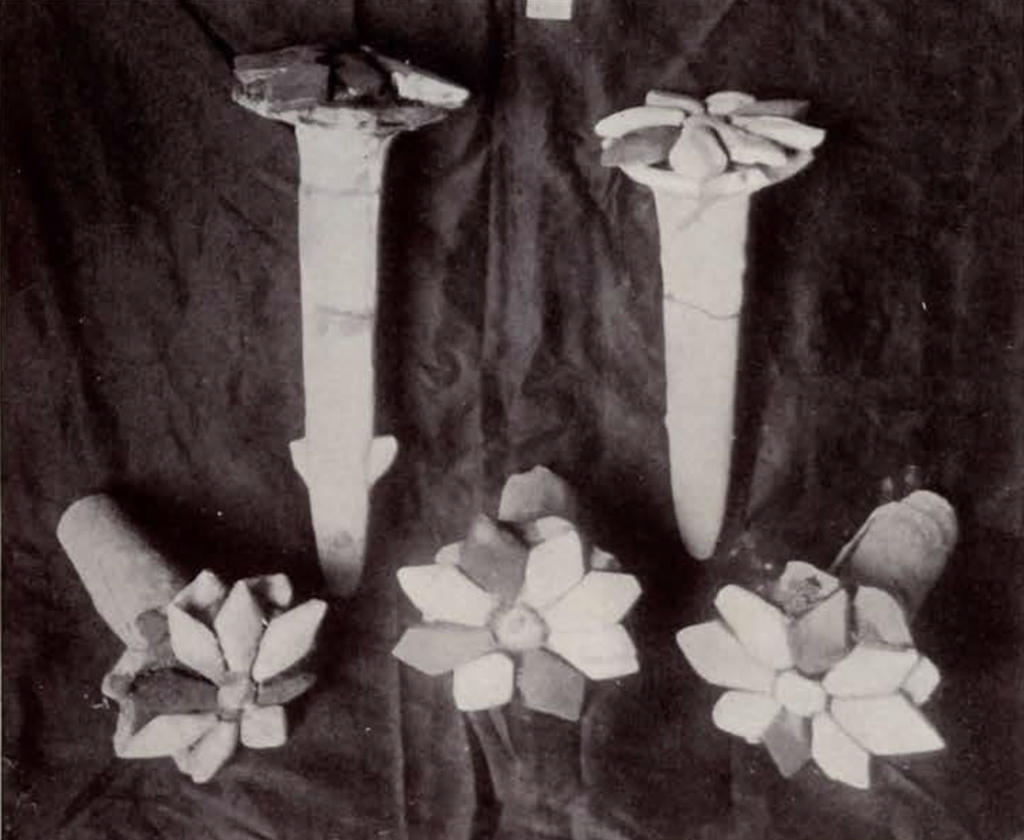
Museum Object Numbers: B15795 / B15796 / B15888
Found close to this last, and probably originally forming part of the same frieze (though its copper frame, not shewn in my photograph, is rather wider than that of the animal scenes) was a limestone plaque spewing a manheaded bull with a bird on its back, the whole carved in low relief ; this is much more characteristic of Sumerian art as it was known to us before the discovery of the Tell el Obeid panels and reliefs, but of such it is an excellent illustration, and the subject, obviously religious, is not without considerable interest. Also more in the known Sumerian style is an engraving on shell, unfortunately fragmentary, of a bull seen against a background of branches and foliage; this was found astray in the debris, and its connection with any scheme of decoration cannot be guessed. A remarkable discovery, due to the rains disintegrating the heavy clods of mud brick, was that of a large gold scaraboid, fifteen millimetres long, engraved on the back with the name of A-an-ni-pad-da, the builder of the Nin-Khursag temple in the First Dynasty of Ur, about B.C. 4340. It is really a rather sensational find, and the form of the bead will appeal strongly to Egyptologists.
The graves continue to produce great quantities of plain pottery, stone vases, copper vessels and tools. The finest single object found so far is a long copper pin with a head formed of a sphere of lapis lazuli capped with gold. The skeletal remains are better preserved than was the case in the graves dug earlier in the season, and I hope to send home soon for scientific examination a number of skulls and other bones, for whose immediate export I have obtained the sanction of the Iraq authorities.
Through the kindness of members of the Royal Air Force I have been able to obtain excellent air photos of Tell el Obeid and of Ur, the latter chewing last season’s work on the Temenos wall and E-Nun-Makh, and the clearance of the southwest face of the Ziggurat.
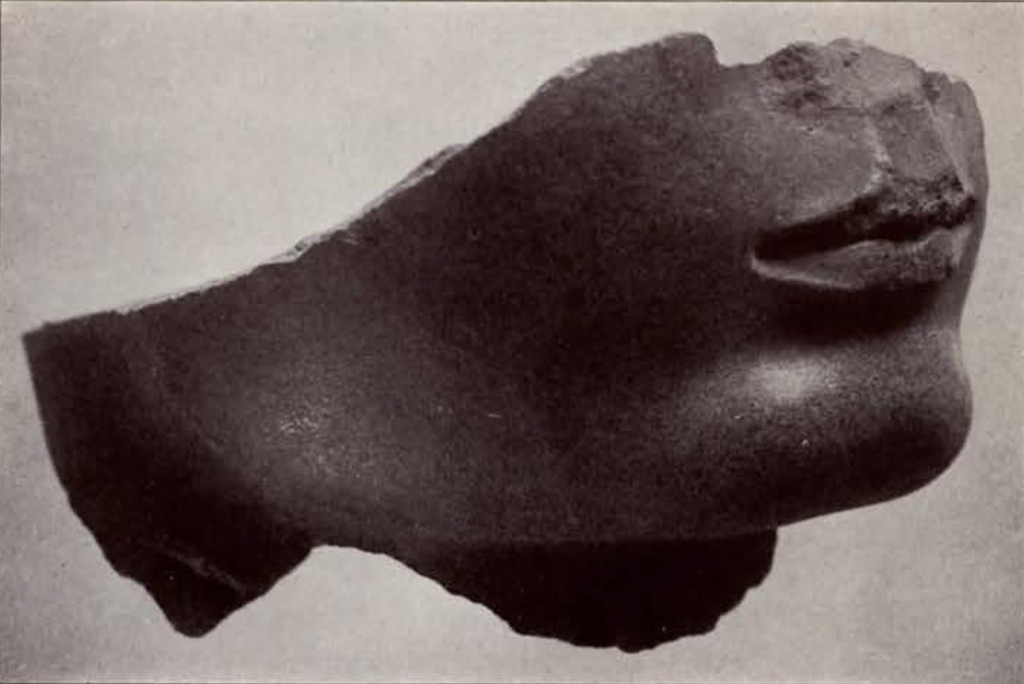
January 31, 1924.
Mr. Newton joined me on the 15th of the month and has taken in hand the work of the plans and drawings. Your staff is therefore now at full strength.
Since for a month or more I had been suffering from constant neuralgia, I took advantage of Mr. Newton’s arrival and on the evening of January 20 went to Baghdad, returning in the night of January 24. This is the first occasion on which a member of the staff has been away since work started. On January 17 Miss Bell, Hon. Director of the Department of Antiquities, paid us a visit, remaining till the following evening.
Work at Tell el Obeid stopped on January 5. The excavation of the Nin-Khursag temple was complete, and on the cemetery as much work hid been done as I considered advisable; the quantity of pottery to ming up was such that its classification, and proper recording presented a formidable task, and the clearing of further tombs seldom did more than duplicate material already found; it may be necessary in future to do more work here, but that is better postponed until the working out of type sheets makes quicker progress possible. A day’s experimental digging on two other cemeteries close to Tell el Obeid, one of Kassite and one of later date, sufficed to prove that both had been too thoroughly denuded to repay excavation.
On January 4, the Ur gang, under Messrs. Gadd and Fitzgerald, was for two days set to work on a site known as Diqdiqah, a piece of low lying ground near the railway, on the outskirts of Ur, whence the men had for long past been bringing in vases and terra cottas (most of the terra cottas obtained last year came from this site). There was no intention of embarking on a big dig, but it seemed essential to ascertain, if possible, the character and date of what was known to be a productive spot. In this we were fully successful. The site proved to be a cemetery; the ground had suffered much from denudation (and probably also from agriculture) and most of the graves had been broken up, the objects from them being found loose in the soil; all the dateable objects, such as cylinder seals and bricks, were of the date of the Third Dynasty of Ur, B.C. 2300-2200. This discovery was as unexpected as it was important, for last season we had assumed that the terra cottas were of late, Neo-Babylonian or Persian period, whereas though we have not found them actually associated with Third Dynasty cylinders in intact graves, yet the evidence for their early date is now convincing; and even allowing for a certain admixture of later examples (for which there is in fact no evidence at all) we are obliged to assign to this early date the bulk at least of the very remarkable series of figures and reliefs from the Diqdiqah site. Some of them are obviously of early and even of primitive type, but others are very surprising for their period; most of the representations are of types hitherto unrecorded.
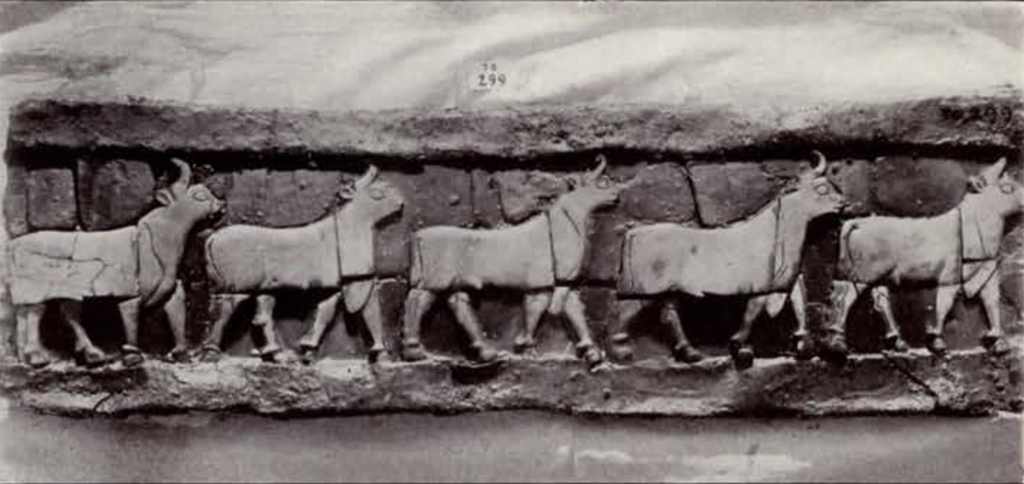
The greater part of the month has been devoted to the excavation of the building mentioned in my last report as lying below the ziggurat and to that of the ziggurat itself. As regards the former building, my first suggestion, that it was a temple of the deified Gimil-Sin, is almost certainly incorrect, as the inscribed door socket on which this suggestion was based was undoubtedly reused and did not originally belong to the construction in connection with which it was found. The real name and use of the building have yet to be discovered.
What we have found up to the present is a great courtyard surrounded by chambers, the whole lying in the north corner of a plat-from raised above the ground level to the northeast and northwest and contained by a massive wall of burnt and mud brick strengthened by heavy buttresses. If we are to judge by the chambers along the northwest side, which alone have been cleared, and are peculiarly long and narrow in proportion to their walls, it might be more correct to say that the courtyard is surrounded by a terrace wall some ten metres thick containing intramural chambers. The courtyard is about seventy five metres long and fifty metres wide and is paved throughout with brick; at each end there are three doors giving access to five rooms, on the northeast side five doors, and on the northwest three. Three sides of the court are decorated with buttresses symmetrically arranged, but the fourth side, that to the southwest, lying in front of the ziggurat, is more remarkably ornate; the whole wall face is composed of attached half columns each relieved by a double or T shaped recess running down its centre, these being built of specially shaped crude bricks mud plastered and whitewashed; parallel to the wall and at a distance of about four metres from it runs a low sleeper wall in the brickwork of which can be seen the circular sockets for free columns whose shafts, almost certainly of wood, have disappeared. On this side then the court was bounded by a colonnade presumably supporting a roof which ran back to the columned wall behind. It is no exaggeration to say that this discovery revolutionizes our ideas of Babylonian architecture. At the conclusion of many years’ work at Babylon the German excavators felt justified in saying that the column was unknown in Babylonia before the Persian period, yet here we have such a columned portico as might have graced a Greek agora or a Roman forum.
The building in its present form was erected by Kuri-Galzu in the 16th century B.C.; below it are earlier remains wherein occur stamped bricks of Bur-Sin, of the Third Dynasty, B.C. 2240, and in one place were found, perhaps in situ, two large inscribed cones of Arad-Sin of the dynasty of Larsa, B.C. 2000. Extensive repairs to Kuri-Galzu’s building were carried out by Sinbalatsu-ikbi, Assyrian governor of Ur under Ashur-banipal, B.C. 650, following the lines of the original ground plan but at a higher level; one of his foundation cones was found in position in a doorway. Later still Nebuchadnezzar, B.C. 604-561, repaved the whole area at a much higher level and dug a well in the north corner; practically the whole of his work has disappeared with the denudation of the site, but judging from the fact that the original doorways continued in use, he too would seem to have retained more or less the old plan.
No attempt is being made this season to excavate the whole of this very large building. The rooms along the northwest wall have been cleared, together with the northwest end of the courtyard; a wide cut has been made along the whole of the columned wall on the southwest, but the actual cleaning of the face of this has been left over until the end of the work, when danger of the destruction of the columns through rain will be less; this is particularly necessary in view of the intention of the Department of Antiquities to take steps for the permanent conservation of so remarkable a feature. For the rest, the walls have been merely traced to a depth of some two feet, whereas they are standing in many places as much as two and three metres high. I hope later on to have the means to clear the southeast end, so as to establish the connection between the court and the E-Nun-Makh temple.
The bulk of the labour during the month has been expended on the clearing of the northeast face of the ziggurat, on which for some time past the whole gang has been employed. Good progress is being made with this work, which is very heavy and consequently slow. Since the presence of the large building described above has made it impossible to throw earth on the low ground close to the ziggurat, the spoil heaps are being carried through the northwest gate clear of the city wall; already we are using in all some five hundred yards of railway, and the distance increases daily. As regards results, I would at this stage say no more than that we have partially cleared the stairway leading to the ziggurat top and the platform built in front of the tower proper by Nabonidus, B.C. 555-539.
As was to be expected, objects have not been numerous this month. Diqdiqah has produced the terra cottas, a quantity of contemporary pottery, beads, including a few nice gold beads, and inscribed cones of Ur-Engur, B.C. 2304, commemorating the digging of a canal, and many cylinder seals. From Ur, our best finds have been an inscribed basalt door socket of Ur-Engur, one in limestone of Kuri-Galzu, B.C. 1580, the latter a better example than most of the Kassite door inscriptions, and a fragment from a life size diorite statue giving the lower part of the face, Third Dynasty work in the style of the Gudea statues in the Louvre but of finer quality than they; this is one of several fragments found below the ziggurat which hold out hope of better things.
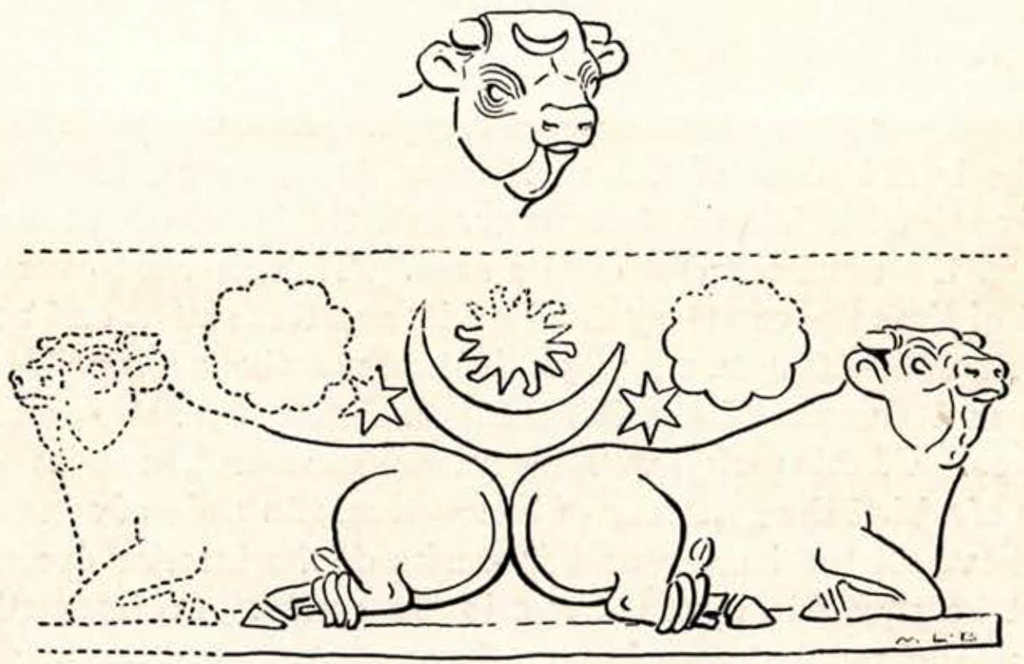
Museum Object Number: B14968
March 8, 1924.
Today the whole working gang was paid off, and this evening the three foremen from Jerablus were sent away. The packing of the antiquities is well advanced, and I hope to take them all down to Basra on Tuesday next; in this connection I should like to express my thanks to the Royal Air Force, which has supplied gratis the many packing cases required, thus saving the Expedition a very heavy item of expense. As the clearing of the Ziggurat has been carried on up to the last moment, Mr. Newton had naturally not been able to complete all the plans and sections, or even to record all the material for the same; consequently the Staff of the Expedition are stopping on here for about another week and will not leave Baghdad until March 19. I have arranged to give a public lecture in Baghdad on the season’s work. On March 2nd nearly one hundred people, British and native, from Basra and the northern towns of the Persian Gulf paid a visit to Ur, in a violent sandstorm. I am sure that the general interest aroused by such visits will be greatly to the advantage of your Expedition, which must depend in no small degree on the good will of the officials and the people.
Since my last report, all work has been centered on the Ziggurat, the clearing of which has been more thorough than had seemed probable. No more has been done on the southwest side, where we had already dug down below the Nabonidus level. On the northeast front the three staircases have been exposed and the ground level was first cleared down to the floor of the Nabonidus period, and then this was removed and the level carried down to that of Adad-aplu-iddina, a king of the Fourth Dynasty of Babylon, B.C. 1085, little known from his monuments, who carried out certain repairs on the Ziggurat and in the courtyard building below. The southeast end was cleared as far as the Nabonidus level, and the northeast end practically the same, but here it was not advisable to go lower, as we would have encountered buildings of the early period whose excavation might well require a whole season’s work.
The Ziggurat, which when we came was simply a mound rather higher than the rest, now stands up isolated as a building which completely dominates the site. On three sides it rises sheer, on the other, the northeast front, three great staircases lead up to the top of the first stage. The central stairs have lost their treads, but the other two flights retain most of their hundred steps and these for the most part well preserved. Of the upper stages not a great deal is left, but there are sufficient indications of the arrangement of the building for Mr. Newton to have worked out a restoration in which little but the details can be called conjectural.
The whole of the lower part of the structure is clue to Ur-Engur, whose Ziggurat underwent little change or repair until the New Babylonian period; on the top we have identified a wall, that of a temple or, more probably, of a platform, belonging to Ur-Engur’s original plan, the corner of which has been dug into by Nabonidus in his search for foundation deposits, but it is impossible to reconstruct the scheme of the earliest building. A remarkable point is the relatively high level occupied by the Ziggurat, whose foundations are very much above the level of the original plain; it was built, from the outset, upon an artificial platform, and it is justifiable to assume that this platform conceals the remains of an earlier building, probably itself a Ziggurat.
Nabonidus did no more than repair the lower part of the Ziggurat, raising the level of the stairs to correspond with the rise in the surrounding ground levels. On the top, he completely remodelled the building, burying the remains of Ur-Engur’s work under his new terrace stages. His upper structure seems to have been curiously irregular. The three flights of steps converge to a point almost (but not quite) in the middle of the northeast front; but the entrance to the shrine, and the stairway leading to it from the lowest stage, were on the southeast. The terraces were not strictly uniform, and the height of the ziggurat was greater at one end than at the other, and the shrine, the highest feature of the building, was not in its centre.
I feel that I ought not to end my last report on the season’s field work without expressing my thanks to my staff. I suppose that to Mr. Fitzgerald, as a volunteer, I ought to feel especially indebted, but as a matter of fact I cannot be more grateful to him than I am to the others for their unwearying assistance and good companionship. The season’s programme has been a fairly laborious one; they have made it both possible and pleasant.

